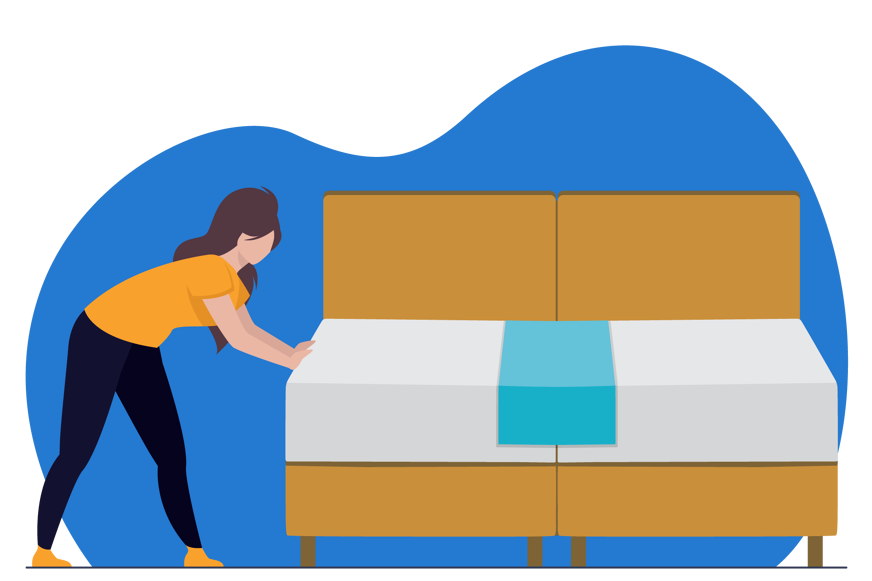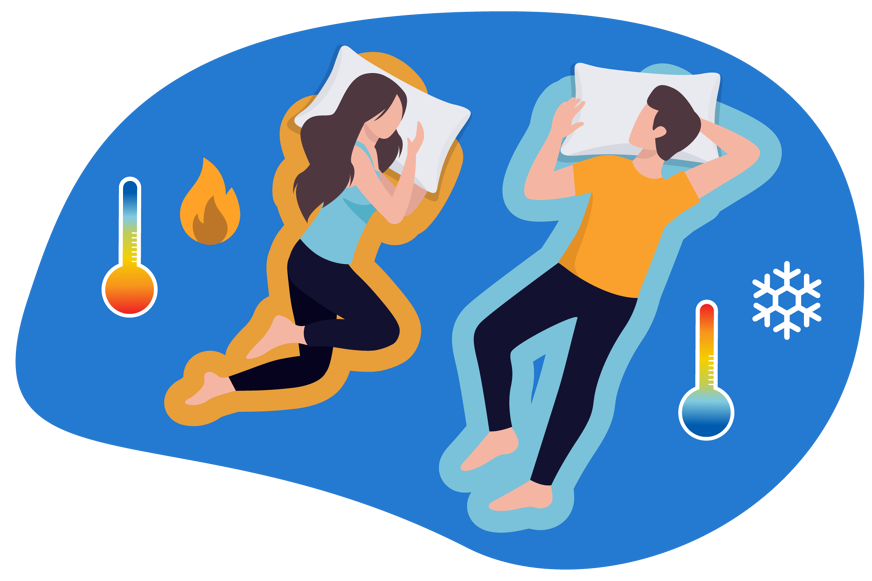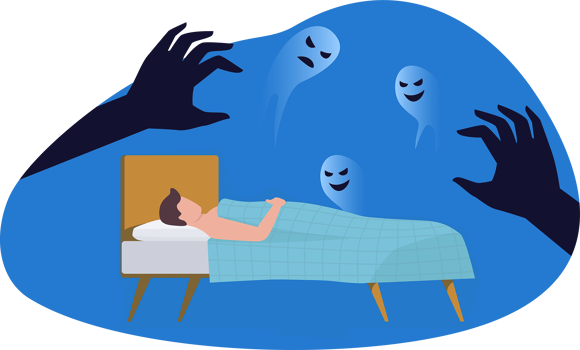The most common sleeping positions for couples
While there is a myriad of sleeping positions for couples [1], we’ve focused on the most common ones.
Below, we’ve listed some advantages and disadvantages of each, as well as some insight into what these positions may say about your relationship.
Spooning
Spooning is a classic cuddling position where one partner lies on their side with their back against the chest of the other partner.

It's like being two spoons nestled together in a drawer, and you’ll often hear references to the big spoon and the little spoon.
- Pros: The pros of spooning include increased intimacy, warmth, and a sense of security.
- Cons: However, it can get too warm, and for some, it might feel too claustrophobic.
- Meaning: This sleeping position suggests a close and affectionate relationship where partners seek physical closeness and comfort.
Back to back
Back-to-back sleeping involves both partners lying on their sides facing away from each other, with their backs touching or not touching.

This position provides individual space while still maintaining physical connection.
- Pros: The pros include personal space and reduced disturbance from each other's movements during sleep.
- Cons: However, it may lack intimacy and physical touch.
- Meaning: Back-to-back sleeping suggests a relationship where both partners value independence and personal space but still want to feel connected.
Face to face
In the face-to-face sleeping position, both partners lie on their sides, facing each other.

This position allows for eye contact and intimate connection throughout the night.
- Pros: The pros include enhanced intimacy, communication, and the ability to kiss or cuddle easily.
- Cons: However, it may lead to discomfort or difficulty breathing for some couples.
- Meaning: Face-to-face sleeping suggests a relationship characterised by strong emotional connection and communication.
The tangle
The tangle is a cosy yet chaotic sleeping position where partners intertwine their limbs in various ways while lying on their sides facing each other.

It signifies a deep emotional and physical bond between partners.
- Pros: The pros include heightened intimacy, affection, and a feeling of being entwined with your partner.
- Cons: However, it can also be physically uncomfortable and may disrupt sleep.
- Meaning: The tangle suggests a relationship filled with passion, affection, and a desire for closeness.
Cliffhanger
In the cliffhanger sleeping position, one partner sleeps close to the edge of the bed while the other partner remains in the centre.

This position suggests a balance between independence and connection.
- Pros: The pros include personal space and the ability to move freely during sleep.
- Cons: However, it may lead to feelings of distance between partners.
- Meaning: The cliffhanger suggests a relationship where both partners value their individual space but still want to feel connected.
Separate sleepers
The separate sleeper position involves partners sleeping in different beds or even different rooms.
While this may seem unconventional, it can work well for some couples.
- Pros: The pros include uninterrupted sleep, reduced disturbances, and the ability to cater to individual sleep preferences.
- Cons: However, it may lead to a perceived lack of intimacy or connection during bedtime.
- Meaning: The separate sleepers position suggests a relationship where both partners prioritise restful sleep and are comfortable with their own space.
What are the benefits of sharing your bed with a partner?
Sharing a bed with your partner can offer a multitude of benefits beyond just physical closeness.
It can promote emotional bonding [2], reduce feelings of loneliness, and improve overall sleep quality [3].
The warmth and comfort of having your loved one beside you can also lead to feelings of security and relaxation [4], making it easier to drift off into a peaceful slumber.
What are the challenges of sharing your bed with a partner?
However, sharing your bed with a partner does come with its challenges.
Differences in sleep preferences, such as temperature, mattress firmness, or preferred sleeping positions, can sometimes lead to disturbances during the night.
Snoring, tossing and turning, or hogging the covers are common complaints that can disrupt sleep for both parties, potentially leading to feelings of frustration or fatigue in the morning.
Tips for sleeping comfortably with your partner
Even if you share your bed with a partner, you should still prioritise and respect each other’s sleep requirements.
Here are a few tips to help you get started.
Choose the best mattress
It’s important to choose a mattress that offers the best compromise in terms of firmness level, feel, and temperature management, and to go for a large-size bed so you both have enough space to sleep comfortably.
You’ll also want to opt for a mattress with minimal motion transfer so you’re less likely to feel your partner’s movement during the night.
If it’s impossible to find one mattress that suits you both, it may be worth considering split mattresses or opting for two single mattresses placed on one king-size bed. 🫶

Our guides on the best mattresses for couples and the best mattresses for sex can help you here.
Choose the best bedding
Choosing breathable, moisture-wicking bedding will help regulate temperature and prevent overheating, ensuring a more comfortable night’s rest for both of you.
You may find silk bedding or something breathable like Aeyla Bedding or Panda Bedding particularly comfortable.
Temperature management
Maintaining a comfortable temperature in the bedroom is essential for a good night’s sleep, particularly when sharing a bed with your partner.
Experiment with different bedding options to accommodate individual temperature preferences.

If you and your partner have vastly different temperature preferences, consider using separate blankets to prevent overheating or discomfort.
Additionally, keep the bedroom cool and well-ventilated to promote optimal sleep conditions for both of you. ❄️
Respect each others’ sleep rhythms
Respecting each other's sleep rhythms and schedules is crucial for sleeping comfortably with your partner.
Communicate openly about your individual sleep needs and preferences, such as bedtime routines and wake-up times, to ensure mutual respect and understanding.
If one partner is a night owl while the other is an early bird, consider using white noise machines, sleep masks, or earplugs to minimise disruptions during sleep.
Establishing a consistent sleep schedule and creating a relaxing bedtime routine together can also promote better sleep quality and strengthen your bond as a couple.
These products may help you sleep better as a couple:
So, is there a best sleeping position for couples?
Whether you're tangled up like a pretzel or prefer your own separate sleep sanctuaries, your chosen sleeping position with your partner is as unique as your relationship itself.
Embrace the quirks, cherish the closeness, and remember that no matter how you sleep, what truly matters is the love you share when the sun rises each morning. ❤️


















Alternatively, message us directly via the Contact Us page.